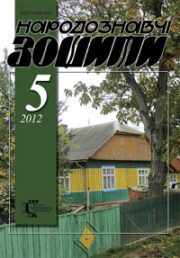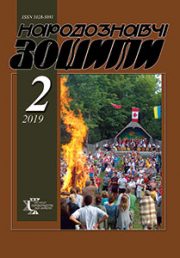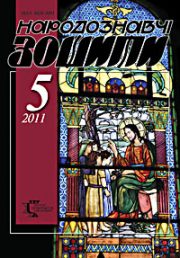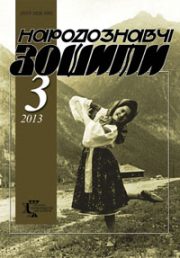The Ethnology Notebooks. 2019, 1 (145), 48—56
UDK [746.4 + 391.4]:687.4(476.704 + 477.804)
DOI https://doi.org/10.15407/nz2019.01.048
VINNIKOVA Mariya
ORCID ID: https://orcid.org/0000-0002-1379-3922
Ph.D. in Art criticism
Senior Researcher,
The State Scientific Institution «The Centre for Belarusian culture, language and literature. Research of the National Academy of Sciences of Belarus»,
Minsk, the Republic of Belarus.
Contacts: e-mail: marya_vinnikova@tut.by
Abstract. The article is devoted to the study of traditional girls’ and women’s head wear that existed in the border areas of the Gomel district of the Mogilev province (Belarus) and the Chernigov district of the Chernigov province (Ukraine) in the late XIX up to early XX century. The girl’s version of the head wear was a «girdle» («opoyaska»), a narrow strip of canvas richly ornamented at the ends and at the forehead area. It was tied around the head without covering the top of the head. The female version of the head wear was meant to wear a «girdle» with a cap of a special shape and the way of wearing it was also different. This head wear was a bright decorative addition to the traditional girls’ and women’s costumes, but a century ago it passed out of use. Currently, its single copies are situated in the collections of Saint Petersburg museums: the Russian Museum of Ethnography and the Peter the Great Museum of Anthropology and Ethnography (Kunstkamera) of the Russian Academy of Sciences. The head wear from the Belarusian collections of these museums became the object of this study. For the comparative analysis we also used the published archival photos from the Ukrainian collections of these museums. As a result, we draw a conclusion on the similarity of the women’s head wear with a girdle that existed in the border areas of Belarus and Ukraine.
On the basis of the study of museum objects, we revealed the constructive and artistic features of the traditional head wear with a girdle. The comparative art history analysis of girls’ and women’s girdles revealed a significant similarity between these kinds of head wear, which was manifested in the similarity of their size and design, in the composition of the decor, as well as in the choice of ornamental motifs and techniques of their performance. The article provides the schemes of ornamental decoration of girdles, three of which are published for the first time. For the first time, a graphic reconstruction of wearing of the women’s head wear with a girdle way is published. The presented materials can be used for further scientific researches and for reconstruction materials of the lost versions of the head wear.
Keywords: traditional costumе, head-dress, «opojaska», embroidery, ornament, reconstruction, Belarusian-Ukrainian borderland.
Received 6.12.2018
REFERENCES
RME № 876212110.
RME № 876212114.
RME № 876212115.
RME № 876212116.
RME № 876212117.
RME № 876212119 /1, 2.
MAE № 41514 /а, в.
RME 151424.
RME № 1388.
RME № 138825 /а, в.
RME № 138826 /а, в.
RME № 1363.
Zelenin, D.K. (1926). The women’s headdresses of Eastern (Russian) Slavs. Slavia, V (1), 305—307 [in Russian].
Svjatskij, D. (1910). Peasant costumes in the area of contact of Orjol, Kursk and Chernigov Governorates. Zivaja Starina, I—II, 3—17 [in Russian].
Zhabinskaja, M.P. (1976). The art of the village of Neglyubka. Minsk: Byelarus [in Belarussian, in Russian].
Vinnikava, M.M. (1999). The traditional female dress of the Usokhskaja Buda village of Dobrush district of Homel region. Ethnography of the Belarussian Padniaprowe (Proceedings of the Scientific Conferens). Mahiljow [in Belarussian].
Stelmashchuk, G.G. (1993). Traditional headdresses of Ukrainians. Kyiv: Naukova dumka [in Ukrainian].
Vinnikova, M.N. (2013). Reconstruction of local variants of the traditional Belarussian costume on the basis of artefacts of museum collections of Russia and Belarus. European cultural area in MAE collections; almanac of the Museum of Anthropology and Ethnography, LVIII, 325—359 [in Russian].
Vinnikava, M.M., & Bogdan, P.A. (2016). Traditional Belarusian costume. Minsk: Belaruskaja navuka [in Belarussian, in Russian].
Lobachevskaja, O.A., & Zimina, Z.I. (2009). Belorussian folk costume: fashion, embroidery, decorative seams. Minsk: Belaruskaja navuka [in Russian].
Prokop’eva, N.N. (2010). Preparation of «the death clothes»: the ways of coding of gender and age status of East Slavs’ olds. Ethnographic material, III (Peoples of Belorussija, Ukraina, Moldavija, pp. 97—122) [in Russian].
Kalashnikova, N.M. (2012). «Shapochnoe znakomstvo»: The collection of headdresses of the Russian Museum of Ethnography. Moscow: Severnyj palomnik [in Russian].







